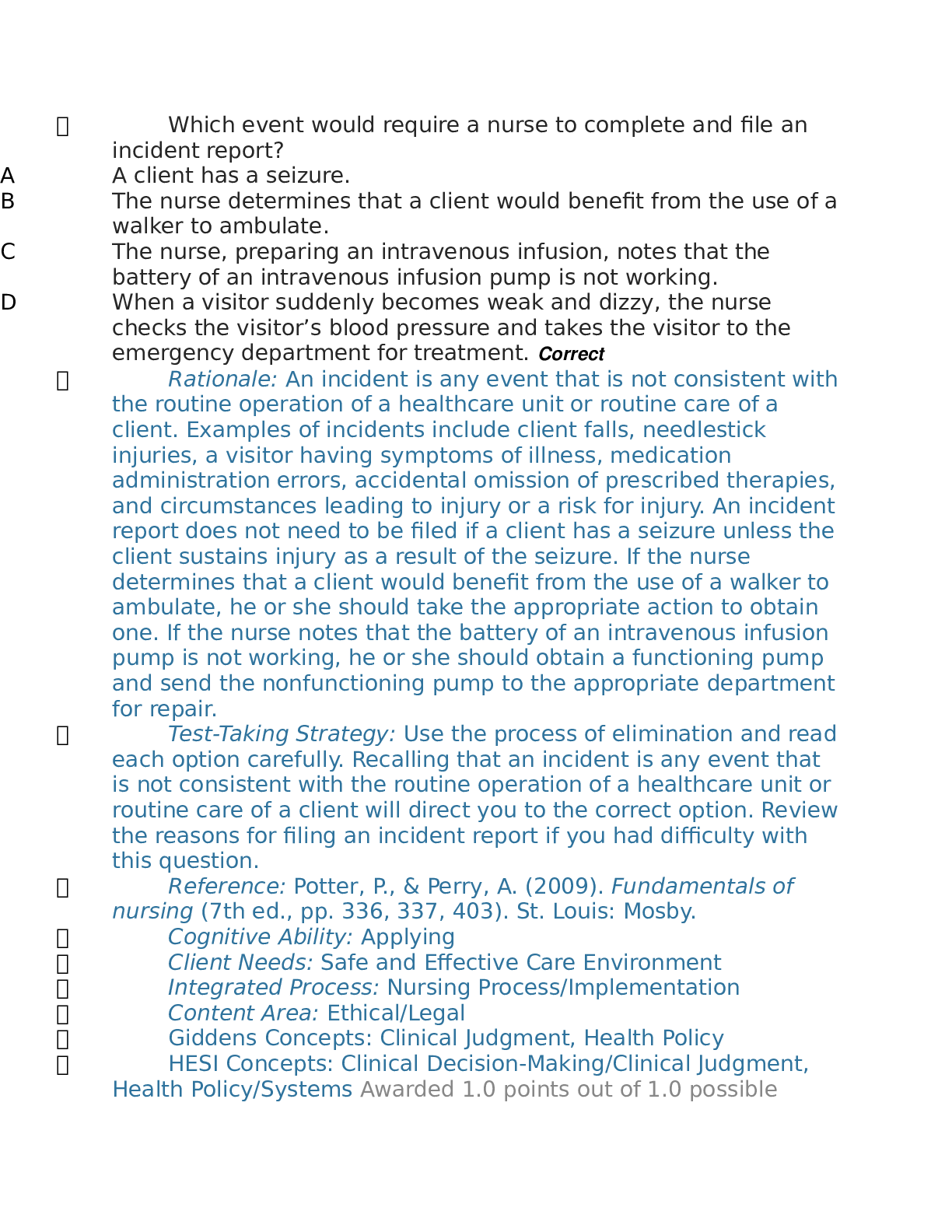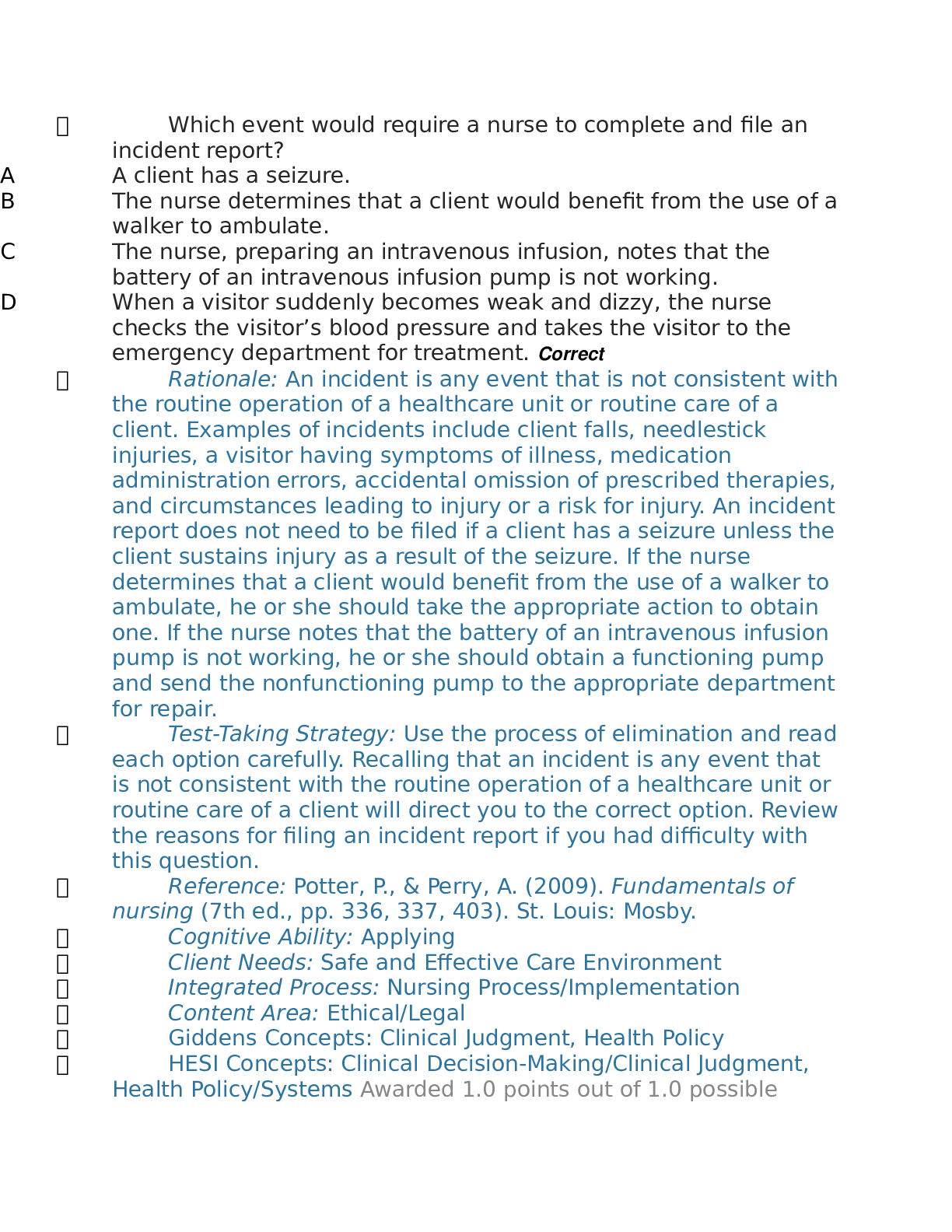dent report?
A client has a seizure.
The nurse determines that a client would benefit from the use of a
walker to ambulate.
The nurse, preparing an intravenous infusion, notes that the
battery of an intravenous infusion pump is not working.
When a visitor suddenly becomes weak and dizzy, the nurse
checks the visitor’s blood pressure and takes the visitor to the
emergency department for treatment. Correct
Rationale: An incident is any event that is not consistent with
the routine operation of a healthcare unit or routine care of a
client. Examples of incidents include client falls, needlestick
injuries, a visitor having symptoms of illness, medication
administration errors, accidental omission of prescribed therapies,
and circumstances leading to injury or a risk for injury. An incident
report does not need to be filed if a client has a seizure unless the
client sustains injury as a result of the seizure. If the nurse
determines that a client would benefit from the use of a walker to
ambulate, he or she should take the appropriate action to obtain
one. If the nurse notes that the battery of an intravenous infusion
pump is not working, he or she should obtain a functioning pump
and send the nonfunctioning pump to the appropriate department
for repair.
Test-Taking Strategy: Use the process of elimination and read
each option carefully. Recalling that an incident is any event that
is not consistent with the routine operation of a healthcare unit or
routine care of a client will direct you to the correct option. Review
the reasons for filing an incident report if you had difficulty with
this question.
Reference: Potter, P., & Perry, A. (2009). Fundamentals of
nursing (7th ed., pp. 336, 337, 403). St. Louis: Mosby.
Cognitive Ability: Applying
Client Needs: Safe and Effective Care Environment
Integrated Process: Nursing Process/Implementation
Content Area: Ethical/Legal
Giddens Concepts: Clinical Judgment, Health Policy
HESI Concepts: Clinical Decision-Making/Clinical Judgment,
Health Policy/Systems Awarded 1.0 points out of 1.0 possibleA
B
C
D
points.
2. ID: 9476944425 A nurse, charting the administration of
medications to an assigned client at 9 pm, notes that atenolol
(Tenormin) was prescribed to be administered at 9 am instead of
9 pm. The nurse checks the client’s vital signs, completes an
incident report, and calls the physician to report the error. The
physician tells the nurse that an incident report is not needed but
instructs her to monitor the client during the night for
hypotension. What action should the nurse take?
Notifying the nursing supervisor
Tearing up and discarding the incident report
Telling the physician that the error warrants the completion of an
incident report Correct
Telling the nursing supervisor that the physician did not want an
incident report completed and filed
Rationale: Incident reports are an important part of a
healthcare agency’s quality improvement program. An incident is
any event that is not consistent with the routine operation of a
healthcare unit or routine care of a client. An example of an
incident is administering a medication at a time at which it is not
prescribed to be given. Whenever an incident occurs, an incident
report is completed and filed in accordance with agency
guidelines. The nursing supervisor would be notified of the
incident; however, on the basis of the data in the question, the
nurse should tell the physician that the error warrants completion
and follow-through with an incident report. Therefore, the other
options are incorrect.
Test-Taking Strategy: Focus on the subject of the question,
the physician’s telling the nurse that an incident report is not
needed. Eliminate the options that are comparable or alike in that
they involve notifying the nursing supervisor. To select from the
remaining options, recall the purpose of an incident report to
select the correct option. Review the procedures involved in
completing and filing incident reports if you had difficulty with this
question.
Reference: Huber, D. (2010). Leadership and nursing care
management (4th ed., pp. 557, 558). St. Louis: Saunders.
Cognitive Ability: Applying
Client Needs: Safe and Effective Care EnvironmentA
B
C
D
Integrated Process: Nursing Process/Implementation
Content Area: Ethical/Legal
Giddens Concepts: Clinical Judgment, Health Policy
HESI Concepts: Clinical Decision-Making/Clinical Judgment,
Health Policy/Systems Awarded 1.0 points out of 1.0 possible
points.
3. ID: 9476948372 Contact precautions are initiated for a client
with methicillin-resistant Staphylococcus aureus (MRSA) infection.
The nurse, providing instructions to a nursing assistant about
caring for the client, tells the assistant:
To transfer the client to a semiprivate room
That gloves only are needed to care for the client
To wear gloves and a gown when changing the client's bed linen.
Correct
To wear a gown when caring for the client and remove the gown
immediately after leaving the client’s room
Rationale: Contact precautions require the use of gloves,
gown, and goggles if direct client contact is anticipated. Goggles
are worn to protect the mucous membranes of the eye during
interventions that may produce splashes of blood or body fluids,
secretions, or excretions. The client should be placed in a private
room or, if a private room is not available, in a semiprivate room
with another client who has active infection with the same
microorganism but no other infection. The nursing assistant would
remove the protective gear before leaving the client’s room.
Test-Taking Strategy: Use the process of elimination.
Eliminate the option that includes the closed-ended word “only.”
Next eliminate the option that involves removal of the gown after
leaving the client’s room. To select from the remaining options,
read each carefully and visualize the procedure instituted for
contact precautions, which will direct you to the correct option. If
you had difficulty with this question, review contact precautions.
Reference: Potter, P., & Perry, A. (2009). Fundamentals of
nursing (7th ed., pp. 655, 663). St. Louis: Mosby.
Cognitive Ability: Applying
Client Needs: Safe and Effective Care Environment
Integrated Process: Teaching and Learning
Content Area: Leadership/Management
Giddens Concepts: Infection, LeadershipA
B
C
D
HESI Concepts: Collaboration/Managing Care—Leadership,
Infection Awarded 1.0 points out of 1.0 possible points.
4. ID: 10466367548 A nurse hears someone calling, “Help! My
bed is on fire!” On entering the room, the nurse finds a client
trying to beat out the flames with a pillow. Place in order of
priority the actions that the nurse should take: Correct
Removing the client from the room
Pulling the nearest fire alarm
Closing the door to the room
Running to get the nearest fire extinguisher
Rationale: A nurse who encounters a fire emergency should
think of the mnemonic RACE. The first step is to remove the client
from the room, after which the nurse should activate the fire
alarm, contain the fire, and extinguish the fire. This is a universal
standard that may be applied to any type of fire emergency.
Removing the client from the room is the first step. Pulling the
nearest fire alarm is the second step (alarm). Closing the door to
the room to contain the fire is the third action. Obtaining the
nearest fire extinguisher to put out the fire is the fourth action.
Test-Taking Strategy: Focus on the subject, the steps to take
in a fire emergency. With this in mind, sequence the actions, using
the RACE mnemonic. Review fire safety if you had difficulty with
this question.
Reference: Potter, P., & Perry, A. (2009). Fundamentals of
nursing (7th ed., pp. 839, 840). St. Louis: Mosby.
Cognitive Ability: Applying
Client Needs: Safe and Effective Care Environment
Integrated Process: Nursing Process/Implementation
Content Area: Delegating/Prioritizing Awarded 1.0 points out
of 1.0 possible points.
5. ID: 9476945972 The mother of a 3-year-old calls a neighbor
who is a nurse and reports that her child just drank some window
cleaner that had been stored in a cabinet. The nurse shouldA
B
C
D
instruct the mother to immediately:
Call a poison control center Correct
Administer an excessive amount of fluids to induce vomiting
Call an ambulance to bring the child to the e
Read More


